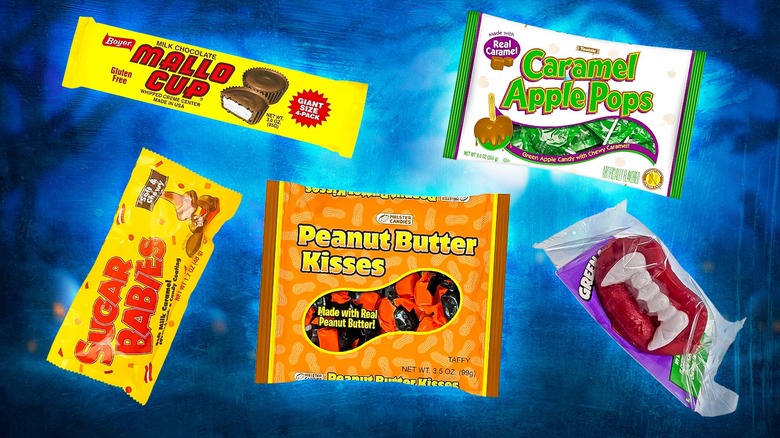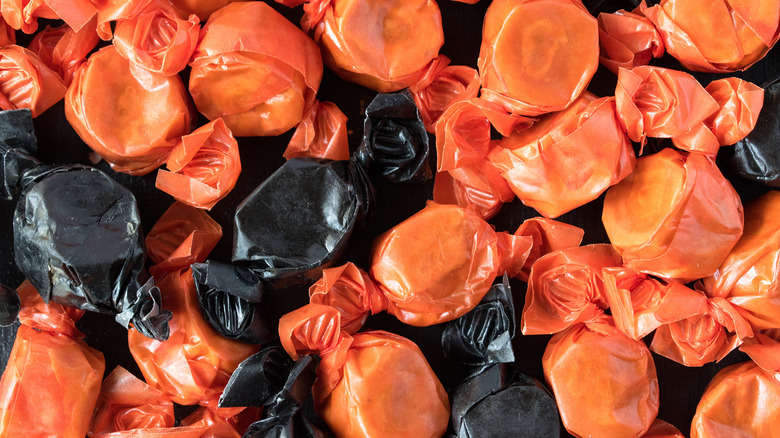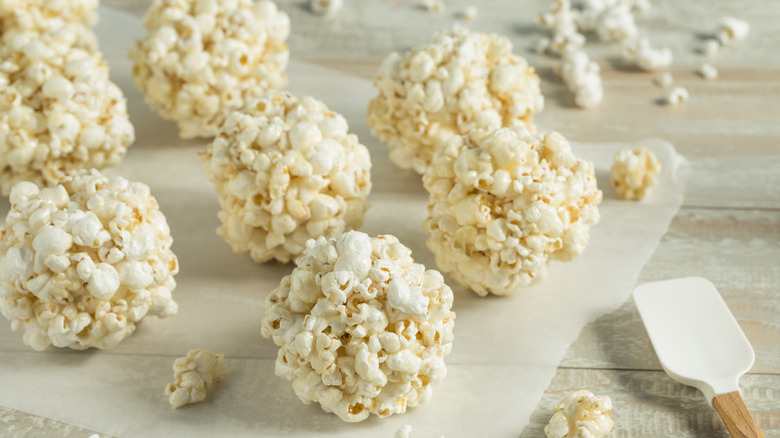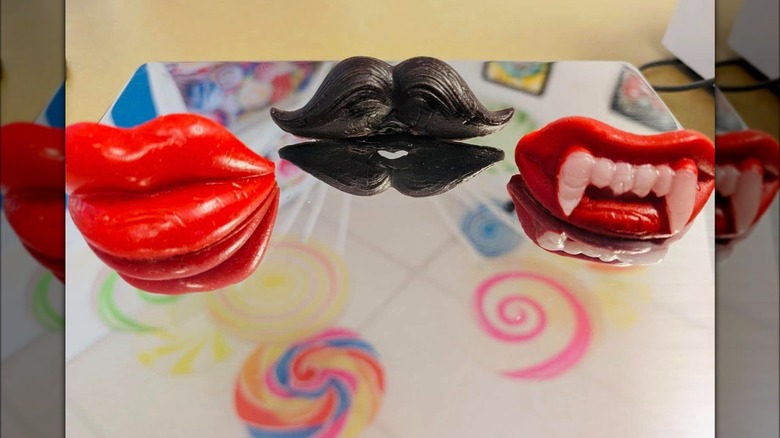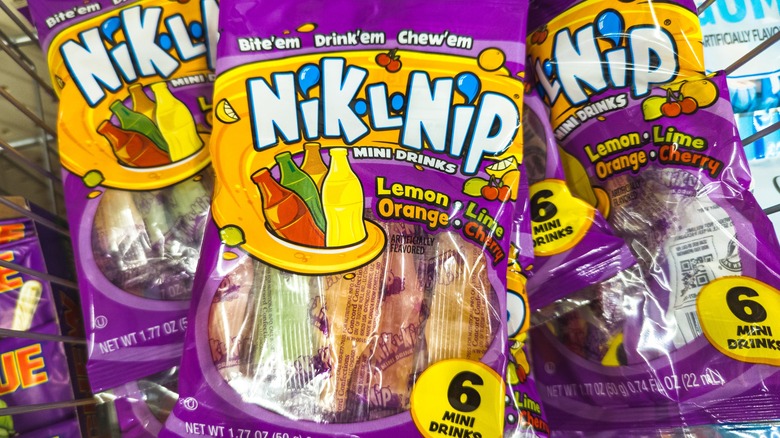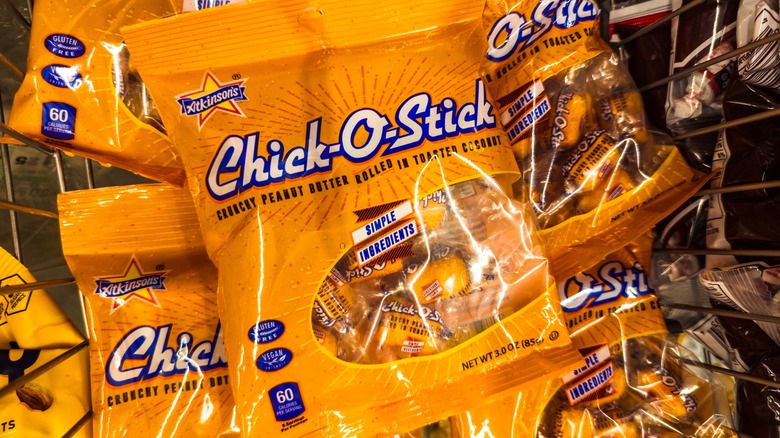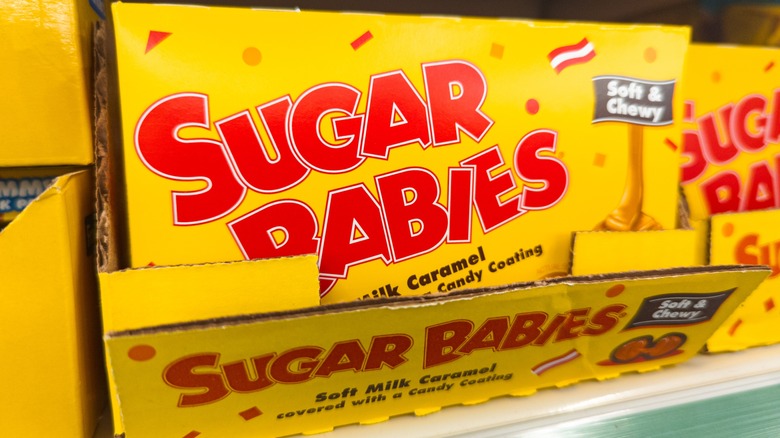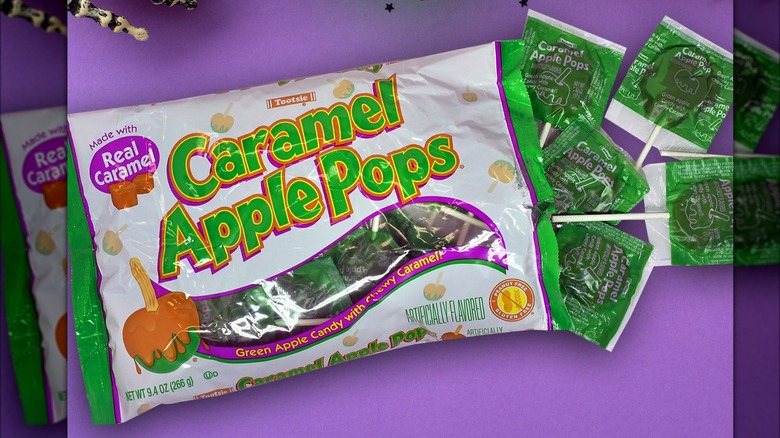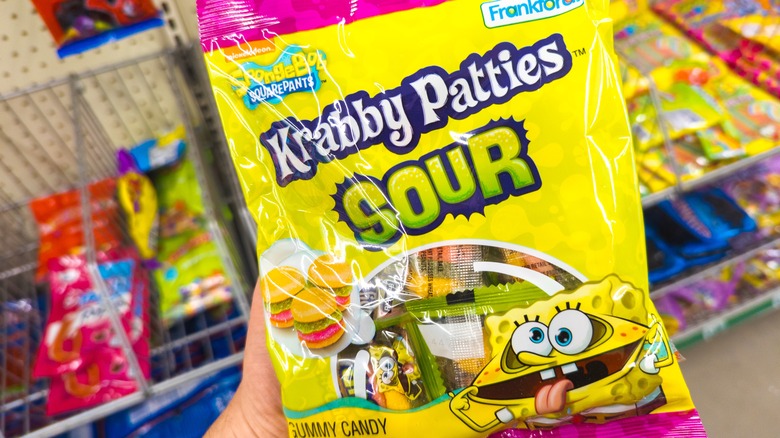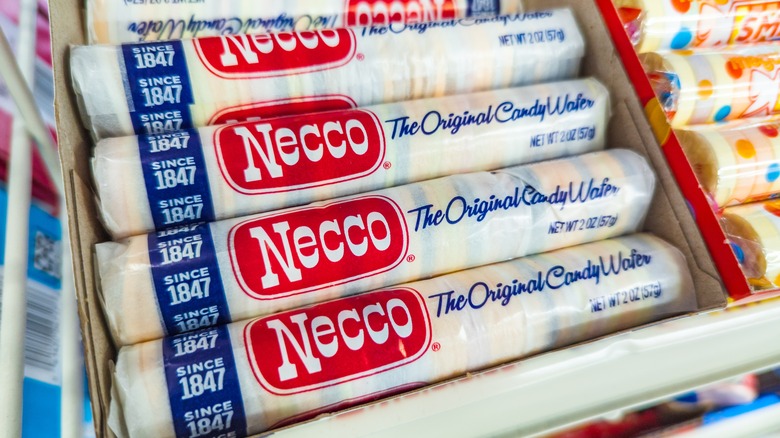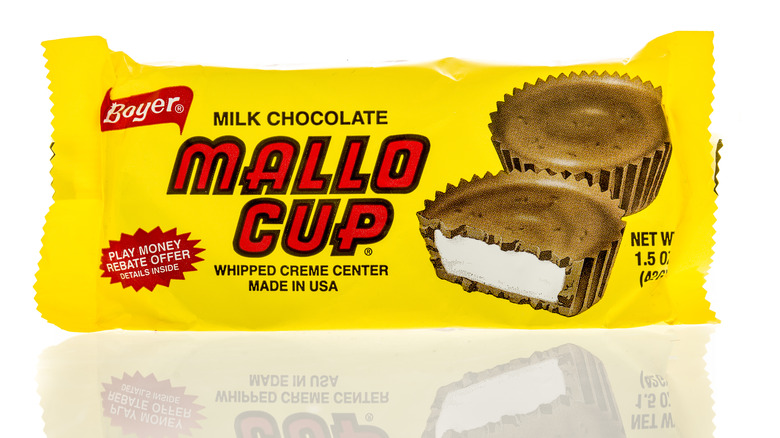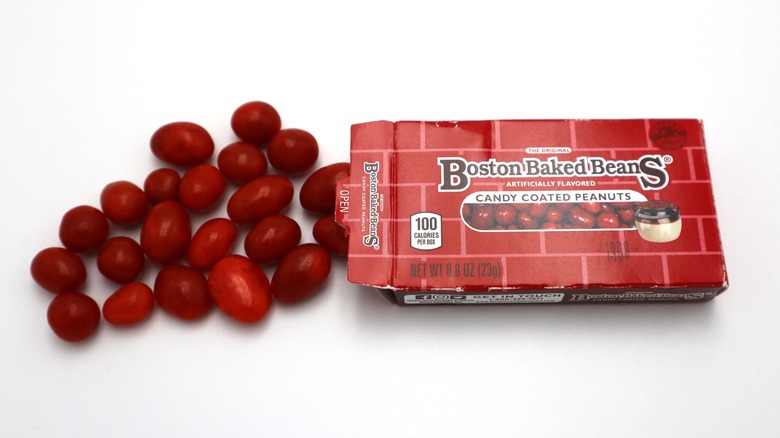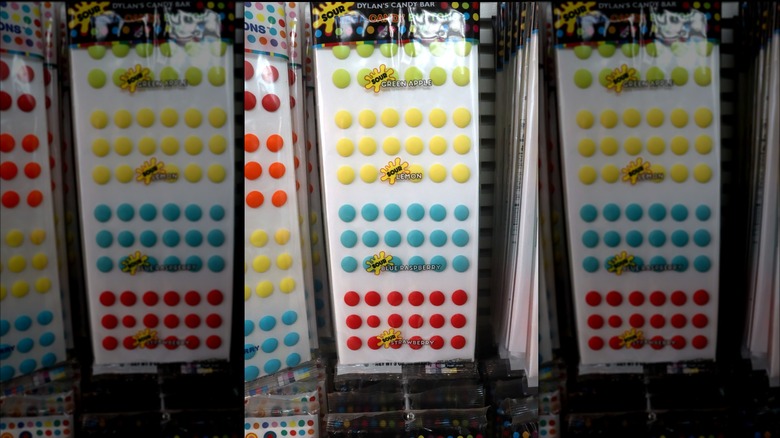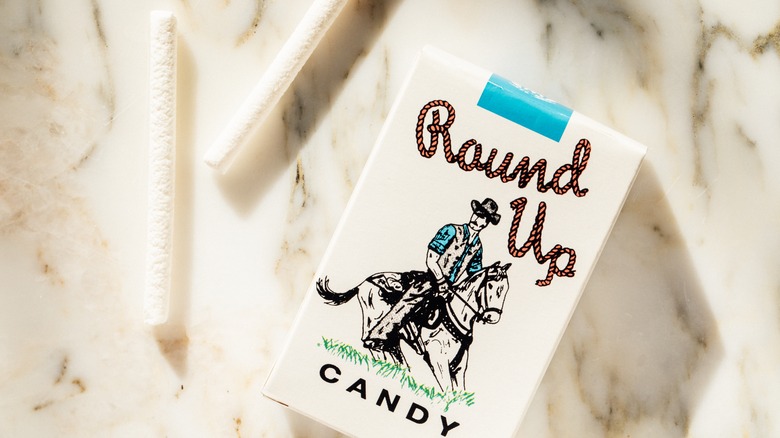13 Old-School Halloween Treats Unrecognizable To Today's Kids
Every year, candy brands roll out new, novelty Halloween treats. Maybe it's a KitKat shaped like Dracula or simply trendy seasonal flavors, like pumpkin spice Hershey's chocolate or pumpkin pie Cow Tales. However, trends and novelties come and go, with the in-demand, most popular Halloween candy changing up every decade or so.
As such, if you're rooting around in your kiddo's candy, hoping to snag some particularly nostalgic treats from your own trick-or-treating days, you're unlikely to find them. Today, while kids might find some novelty treats rolled out for this year and this year alone, their buckets are overwhelmingly filled with candy classics that have stood the test of time: Reese's peanut butter cups, M&Ms, Milky Ways, and Twix. In fact, if you ever were to somehow stumble upon some of the Halloween loot that you snagged in decades past, there's a chance that the children in your life might find those goodies an absolute oddity — as would be the case with these 13 old-school Halloween treats unrecognizable to today's kids.
Peanut butter kisses
You may not know this old-school candy that's rarely given out anymore by name, but you likely know it on sight. The waxy orange and black wrappers are iconic. There's no branding on the wrapper, and it's nothing fancy — and maybe that old-fashioned aesthetic is part of the reason why these Mary Jane Peanut Butter Kisses are one of the most-hated Halloween candies of all time. Think that's a little dramatic? In 2018, one city in North Carolina (half-jokingly) posted on its Facebook page that residents were banned from handing these candies out on the holiday.
Invented by the same company that introduced the world to the almost equally maligned Mary Jane candies (which are still available for purchase and feature a similar flavor profile), Mary Jane Peanut Butter Kisses offered up a simple combination of molasses, peanut butter, corn syrup, sugar, corn starch, soy lecithin, and salt. As for the texture, think really tough taffy with a weirdly chalky center. It's no wonder that Mary Jane Peanut Butter Kisses have gone the way of the dodo — likely to the great happiness of trick-or-treaters everywhere.
Homemade popcorn balls
If you were a kid who grew up in the 1980s or 1990s, then you probably heard your fair share of horror stories revolving around contaminated Halloween candy. Today, experts say that community members handing out candy that had been poisoned or otherwise tampered with is an urban myth, but parents may still raise an eyebrow at letting their children accept anything homemade from strangers on Halloween night — like homemade popcorn balls.
A particularly nostalgic treat, popcorn balls were a very popular Halloween offering in the 1950s. However, it's estimated that the history of the popcorn ball goes back much further than that, all the way to the mid-1800s. In fact, popcorn balls were so popular before the 20th century that one could even purchase a popcorn ball press, which allowed the user to shape molasses or sugar-covered popcorn into equal, consistent balls, negating the need to shape the piping hot ingredients by hand. Now, you can still buy mass-produced popcorn balls to hand out to trick-or-treaters, but even if parents are a little more receptive to the packaged product versus the homemade treat, the children may not be quite so thrilled.
Wax fangs
We can thank an interesting turn in American history for the advent of wax fangs and wax lips, a once-popular treat that was part plaything, part waxy snack. In the late 1800s, kerosene lamps became the go-to light source for most households, so the candle industry needed to switch gears. The industry discovered that paraffin, a kerosene byproduct, was not only great for candles, but also all sorts of other products — like candy. By the early 1900s, food-grade paraffin had been turned into novelty candies like wax lips, wax teeth, wax mustaches, and, for Halloween, wax fangs.
Today, Tootsie Roll still produces cherry-flavored Wack-O-Wax fangs, Wack-O-Wax mustaches, and Wack-O-Wax lips (though the lips come in even more flavors, including blueberry, orange, lime, grape, and lemon). Modern kids may recognize these treats — branded with the tagline "play now, chew later" — more from watching the holiday favorite "The Christmas Story" with the family than from trick-or-treating.
Nik-L-Nip
Just like Wack-O-Wax fangs, another waxy treat called Nik-L-Nips are likewise still produced by Tootsie Roll. They came about as part of the big boom that started using food-grade paraffin wax in candy about a century ago. As for this candy's name, the origin of "Nik-L-Nips" is contested. Some say that the name refers to the candy's starting nickel price tag as well as the way you can nip off the top of the bottle-shaped wax to get to the tasty liquid center. However, others say that it's a play on the Prohibition-era use of the word "nip" to refer to small servings of liquor.
Technically, you're not supposed to actually eat the wax used for Nik-L-Nips. You're just intended to bite through the wax to get to the sugary, fruit-flavored juice in the center and then chew on the wax to get the rest of the flavor out before discarding. Beyond wax fangs and waxy juice-filled bottles, other types of wax candy popular during the mid-20th century included wax guns, wax animals, and wax whistles.
Chick-O-Stick
This is one vintage snack that people loved to eat in the 1930s, but you might turn your nose up when you hear what this candy was initially called: Chicken Bones. Not exactly the most appetizing name for a Butterfinger-esque candy. Luckily, the company that produced (and still produces) the long, yellow-orange sticks covered in coconut, saw that perhaps "Chicken Bones" wasn't a great name and re-dubbed the treat Chick-O-Stick.
The Chick-O-Stick formula was originally based on recipes from the family that founded the Atkinson Candy Company. While things changed over the years (and processed ingredients were added to the recipe, such as artificial dyes, preservatives, and hydrogenated oils), more recently, Atkinson Candy is trying to take Chick-O-Stick back to its roots — perhaps a move that might increase popularity with modern consumers? The company said in 2019 that it would move to making Chick-O-Sticks with zero artificial flavors and colors, instead relying on ingredients like turmeric for color and vegetable juice to flavor the sticks made of roasted peanut butter and toasted coconut.
Sugar Babies
You might remember getting some Sugar Babies in your Halloween bucket throughout your youth — the small, chewy caramels tucked inside a bright yellow packet — but did you know that there's an entire family of such sugary treats? The first in the family was the Sugar Daddy, which offers the same flavor in a large, sucker form that's not quite so chewable. Originally introduced in 1925, the Sugar Daddy was initially called the Papa Sucker, but then the name was changed in 1932. A few years later, Sugar Babies were introduced. The Sugar Mama didn't come around until the 1960s. This candy was the same as the Sugar Daddy but with a chocolate coating. Sugar Mamas were discontinued in the 1980s, before being reintroduced in the 2000s ... only to be discontinued again.
But with Sugar Daddy and Sugar Babies still being sold, why don't you see them more often? The decline could be chalked up to the supposed tweaks to the Sugar Babies formula. One fan reports that, over the years, the texture of Sugar Babies has changed, giving the candy more of a jelly bean or Tootsie Roll consistency versus the old caramel consistency. Others report a similar switch with the Sugar Daddy, noting that the candy is much easier to chew nowadays. When it comes to both candies, though, long-time fans admit that the change probably saves money on dental bills.
Caramel apple pops
Caramel apple pops are still relatively new when compared to other forgotten Halloween candies. They were introduced in 1995. Even if you're a Gen Z-er, chances are you may have found this sucker in your Halloween bucket at some point. Produced by Tootsie Roll, the suckers feature a green apple candy covered in caramel.
At their release, these pops were hugely popular and would remain so for years. In fact, in 2003, Dairy Queen released a special caramel apple pop blizzard that featured vanilla ice cream, caramel, a green apple topping, sour apple flakes, and candy pieces (and a shockingly green hue). The blizzard also came with a caramel apple pop that you could literally use as your spoon. One reviewer called it particularly good for kids, with the right balance of fruity sweetness and sour candy.
You can still buy caramel apple pops in stores, and fans of the pops still exist, even if many have forgotten about them. The only downside? Fans report these pops put you at risk for pulling out a tooth or two.
Krabby Patties
Another Halloween treat whose popularity has waned are Krabby Patty gummies, which came out in 2003, just before the 2004 release of "The SpongeBob SquarePants Movie." Each individually packaged gummy featured a Krabby Patty, made up of a gummy bun, patty, and slice of lettuce (though some say the green slice is a pickle) that could be disassembled or eaten whole.
Over the years, gummy manufacturer Frankford Candy has released different variants of the candy, even as recently as 2024 with the introduction of the Krabby Patties Secret Menu Challenge — a box of all-white Krabby Patties with pieces in various mystery flavors like mustard, pickle, bacon, seaweed, green apple, cherry, grape, popcorn, and blue raspberry. Still, those who loved the original Krabby Patties have more or less abandoned this one-time Halloween favorite, and they seem to be less frequently available at stores than in years past.
Necco Wafers
Much like popcorn balls, Necco Wafers go way back — way, way back. Invented in 1847, Necco Wafers have traveled to the ends of the Earth and to the frontlines of battle in World War II, beloved because they were a treat that wouldn't spoil for up to two years, no special care required. With a snappy, albeit chalky, texture, Necco Wafers originally came in a wealth of flavors, including orange, lemon, lime, clove, chocolate, cinnamon, licorice, and wintergreen. Necco Wafers have been described as having the same flavor as Valentine's Day candy hearts, just in a thinner package. They have also been likened to Tums.
While Necco did introduce a few new flavors over the century-plus of the brand's existence, the product has remained more or less unchanged. In fact, it's estimated that Necco Wafers is the oldest American product continuously manufactured and sold in its original form. In 2009, when Necco decided to try updating its wafer recipe, fans rioted, and the wafers remained as they always had. While this is certainly something to boast about, evolution can sometimes be a good thing. While Necco Wafers pack plenty of nostalgia, many associate the candy with parents or grandparents, rather than anything they'd purchase for their own kids.
Mallo Cups
Once you know what they actually are, the name "Mallo Cup" seems pretty straightforward. It's a peanut butter cup-like candy, but instead of peanut butter, it features a marshmallow filling encased in chocolate. Produced by Boyer Candy Co., Mallo Cups were invented in the 1930s by the Boyer family. However, while Mallo Cups were a big hit well into the 1950s, Boyer Candy Co. has struggled to remain relevant in the modern era.
The candy company changed hands several times in the latter half of the 20th century. Then, in 2001, the death of the company's owner at the time kicked off a legal battle. As family members vied for control of the company, production fell off, and Mallo Cups began disappearing from store shelves. A few years later, a new CEO was brought in to try to help the company get back on its feet through efforts such as lowering its minimum order requirements and introducing new products like a dark chocolate Mallo Cup. As of 2010, the company was producing about 600,000 Mallow Cups per day.
Boston baked beans
No, no — we're not talking about a sweet-savory side dish that you'd prefer to eat alongside a hot dog or hamburger. Instead, Boston baked beans were a popular candy through the 1920s and 1930s, produced by the Ferrara Candy Company (which also makes a ton of more popular candies, such as Nerds and Laffy Taffy). The candy indeed looks like baked beans minus the sauce, but it's actually just peanuts in a red, sugary shell. Located in Chicago, Ferrara Candy Company began producing the confection based on founder Salvatore Ferrara's knowledge of making sugared almonds back home in Italy. In fact, when he first opened his confectionery, his Jordan almonds were his most popular product.
While Boston baked beans may seem simple, the candy is actually pretty complex, due to the cold panning process used during manufacture. Over four days, peanuts are slowly combined with sugar in a revolving pan. As the peanuts go around and around in the revolving pan, they are cooked, taking on the layers of other ingredients, in a process that's a little like culturing a pearl. Unfortunately, even with this complexity, Boston baked beans don't have quite the following they once did, with fans reporting they're often difficult to find and non-fans saying they taste stale and plastic-y.
Candy buttons
Candy buttons are about as straightforward as it gets. Sugar is cooked, along with any desired flavorings or dyes, and then a machine — literally known as a candy button machine — forms the mixture into small button-shaped pieces, placing them on paper where they harden into little bits of candy to be scraped off and enjoyed at will. While the initial inventor of the candy button is up for debate, it's estimated that the candy button really took off in the 1930s.
For a time, Necco held the monopoly on candy buttons, producing an estimated 750 million candy buttons annually. However, Necco went bankrupt in 2018, and its brands, like Necco Wafers, were distributed to the highest bidders (Necco Wafers, for example, is currently owned by Spangler, the company that also produces Dum-Dums lollipops). Doscher's Candy Co. took the candy buttons, and, through a great amount of effort, made candy buttons the very first of Necco's former offerings to return to store shelves under new parentage. Doscher's Candy Co. inherited Necco's candy button machines and makes the candy buttons just as they were being made during their advent, with some of the necessary machinery possibly dating all the way back to 1906.
Candy cigarettes
Sure, if you scour the internet and hit up novelty gift shops, you may be able to find some old-fashioned candies, even if they're not exactly making their way into your child's Halloween bucket. However, you'll be very hard-pressed to find this once-beloved treat, no matter where you look: candy cigarettes, which have actually been outlawed in some markets.
Like many of the aforementioned treats, candy cigarettes boomed in popularity in the 1930s. The sugary white sticks were packed in boxes that looked like real cigarette cartons, with the exterior marketing to match. They often featured a red tip on one end of the stick to mimic a lit cigarette. However, parents quickly became concerned that feeding their children mock cigarettes could lead to early smoking. North Dakota banned the sale of candy cigarettes from 1953 to 1967. Abroad, other countries have full-on banned the candy altogether, including the United Kingdom, Canada, Saudi Arabia, and Finland. However, the products are still legal in the U.S. under one caveat — the word "cigarette" can't be used on the packaging. Still, the products look very much like cigarettes in candy form, even if they're merely called "candy sticks."
